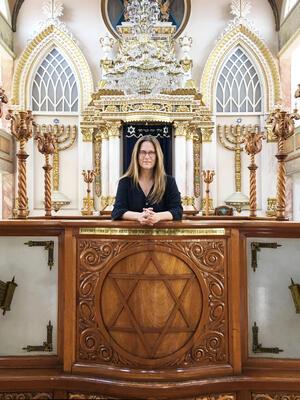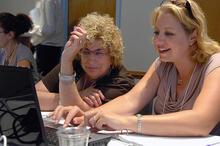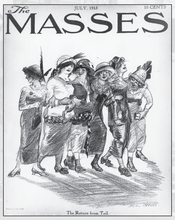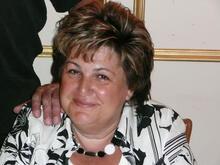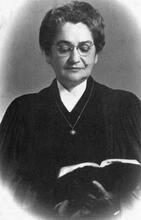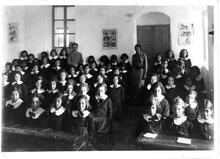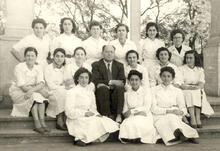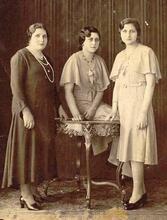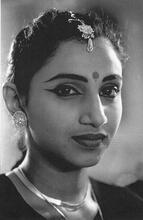Monica Unikel
A Mexican-Jewish ethnologist and chronicler of immigrant stories, Mónica Unikel-Fasja offers a dozen walking tours to diverse Jewish immigrant quarters in Mexico City that encompass the wide historical span of 1500 through the 1950s. She urged the renovation and renaissance of the oldest Ashkenazi synagogue in the city’s historic district, had it designated a Jewish cultural center in 2010, and remained as the Creative Director. The restored Historic Synagogue Justo Sierra 71, celebrated as a culture center since 2010, became the only synagogue in the country fully open to the public, until a second one followed suit in 2019 when it opened adjacent to a Jewish research center. With a team of tour guides and an array of innovative programing at this bastion of Jewish culture, Unikel-Fasja has educated thousands of all ages―Mexican Jews, Catholics and other non-Jews alike―and elevated an enthusiasm for their own historical heritage.
Mónica Unikel-Fasja, a renowned chronicler of unwritten narratives and protector of Jewish patrimony, offers a dozen walking tours throughout diverse Jewish immigrant quarters in Mexico City’s historic neighborhoods, as she has since 1995. A granddaughter of Eastern European Jewish immigrants, she rescues and retells stories of the various aspects of Mexican Jewish immigrants’ experiences in the twentieth century, while integrating an account of Jewish contributions to the history and architecture of Mexico.
A scholar of the streets, Unikel-Fasja acquired her material by diligently surveying, observing, and questioning locals, not by sitting in classrooms. She founded the Jewish cultural center based in the Historic Synagogue Justo Sierra 71―built in 1941 to house emigrating Ashkenazi Jews who were versed in Yiddish but not Spanish―and remained as its director after the doors opened to the public in 2010. Her mission: to reach and enrich visitors and to build a bridge between the oldest Ashkenazi synagogue in Mexico City and the predominantly non-Jewish inhabitants of its surrounding barrio and beyond.
Early Life and Education
Mónica Unikel Pupko, born on May 11, 1963, in Mexico City, shared her early life in the southern neighborhood of Colonia del Valle with her older brother Daniel (1961–1997) and younger sister Halina (later Unikel de Gittler, b. 1969). Their parents, Alejandro Unikel (1938–2019) and Naomi Pupko (1939–2020), grew up in Jewish homes, married in 1959 at the Salón Chapultepec, and raised their children in a household infused with classical music and literature.
Unikel-Fasja’s father left his career as an architect to become an advisor to members of the Halebi community (Jews who had immigrated to Mexico from Aleppo, Syria), entrepreneurs who needed advice on restructuring their family businesses. This led to his training in psychology and ultimate clinical practice as a therapist of logotherapy (based on the premise that people need a meaningful purpose in life). He wrote two professional publications, inspired by the Viennese psychiatrist Viktor Frankl, who developed and tested the treatment on himself while a prisoner of the Nazis in a concentration camp. Unikel-Fasja’s mother opened Pastelería Hadasa, a gourmet bakery and delicatessen with original recipes, in 1977.
From preschool to middle school (1966–1976), Unikel-Fasja attended The Jewish School of Mexico (El Colegio Israelita de México), a private Jewish day school that integrated a cultural and linguistic Yiddishist curriculum into the secular Spanish-language education mandated by the Minister of Public Education (Secretaría de Educación Pública). For high school (1977–1981), she transferred to The Hebrew School Tarbut (El Colegio Hebreo Tarbut), another Jewish day school primarily focused on the Hebrew language and Zionism. Like most young Jews in Mexico, she initially joined the Jewish Girl Scouts of Mexico and later transferred to the Socialist-Zionist youth movement, Yijud Habonim. Between 1981 and 1982, she worked at Kibbutz Yakum in Israel.
Although Unikel-Fasja was a product of two Jewish day schools, where she learned Hebrew and Jewish history and culture, she rebelled against the mainstream education she received in private school. While in high school, searching for a paternal-inspired “meaning to her life’s circumstances,” she enrolled in an after-school program at the Jewish Studies Center (Centro de Estudios Judaicos). There, her passion for everything ethnic ignited. An Argentinian-born, Modern Orthodox Rabbi, Yerahmiel Barylka, taught courses in religion and Judaism, and a notable Mexican-Jewish author, Esther Seligson, passed on her interests in several disciplines, including Jewish philosophy, cultural history, comparative religion, art, theater, and mythology.
In 1982, Unikel-Fasja enrolled at the National School of Anthropology and History (Escuela Nacional de Antropología e Historia), to study ethnology, and after two years, transferred to the Ibero-American University (Universidad Iberoamericana), where she received a bachelor’s degree in sociology in 1989.
Marriage and Family
At the age of 22, Unikel-Fasja met Elias Fasja Cohen (b. 1952), a Mexican-born Syrian Jew who founded a Sephardic poetry and music group called Grupo Sefarad. At that time, Elias was producing a play about the renowned Carvajal family of converso Jews during the Mexican Inquisition (1571 to 1820). Linked by their interests, his in the history of the Inquisition and hers in Jewish ethnology, they married on March 1985 at the mid-sixteenth-century Hacienda de los Morales by both an Jews of European origin and their descendants, including most of North and South American Jewry.Ashkenazi and a Halebi rabbi. Fasja ultimately used his professional interests to become the founder and director of Tycoon Enterprises in the international licensing and merchandising business. Because Fasja observed Orthodox religious practices and Unikel-Fasja remained a free thinker and atheist, their household became an amalgam of tradition and secularism. Today, the family observes kashrut and Jewish rituals in an Orthodox manner, and Unikel-Fasja embraces SabbathShabbat as “a gift for life,” but on her own terms (Unikel-Fasja, 2019).
The couple have three children. The eldest daughter, Irit Fasja (later de Cherem, b. 1988), received a master’s in psychology and developed a strength training methodology; the second daughter, Tamar Fasja (later de Cohen, b. 1991), studied fashion design and later opened an online business of Mexican-inspired Jewish pastries; and the son, Jacobo Fasja (b. 1994) lauched a career in music production, mostly of Hip Hop.
Professional Life: From Leading Tours to Preserving History
A dedicated mother, Unikel-Fasja’s career didn’t start in earnest until after her children were of school age. In 1993, she travelled to Europe to participate in a walking tour of Jewish London, where she realized the importance of learning directly from the streets. Upon returning to Mexico City, she created and offered the first formalized instructive walking tour of Jewish Mexico City.
La sinagoga de Jesús María y otras historias: judíos en México (The Synagogue of Jesus Maria and other histories: Jews in Mexico). Mexico: TV UNAM, 1998. Mónica Unikel-Fasja was heavily involved in the filming of this documentary, which showcases her work of oral history in the streets.
Although Unikel-Fasja considered the tours a temporary pastime, by mere serendipity she transformed herself into the new repository of abandoned and misplaced information that had never made it to the formal archives of Mexican Jewry. Families sent her their old photographs, letters, and newspapers of deceased relatives. As the documentation increased, she became an appraiser and archivist of the past and followed her independently designed research methodology by tracing the steps of the remaining Jews who lived in tenements or worked as merchants in the immigrant quarter. She searched for commercial advertisements from 1920s and 1930s Yiddish Mexican newspapers; strode through the mostly Jewish-settled Jesús María Street; knocked on doors of the colonial buildings that once housed the first Jewish school (established in 1924) or a maternity hospital; entered businesses with names like La Palestina and La Varsoviana, kosher butcheries that sold pickles and herrings, and Yiddish bakeries that baked hallah and rye bread. She tracked their original owners or relatives to interview and uncovered the residents’ and merchants’ histories through endless questions concerning how they dressed, what they ate, and how they furnished their homes, found merchandise, and operated their businesses.
Two decades after her first walking tour, and with a well-trained team of guides, Unikel-Fasja still offers a dozen excursions to diverse Jewish immigrant barrios established between 1500 and the 1950s. The accounts compare the visible renovated buildings with black-and-white photographs of their original facades. They bring to life the early twentieth-century Ashkenazi immigrant quarters of La Merced (originally a monastery that became a market and then a neighborhood); the Syrian Jews who settled Colonia Roma between 1930 and 1960; Jews at the time of the Mexican Inquisition (1500s-1600s) and the Mexican Revolution (1910-1920); the origins of Jewish education (1920s); synagogues of the diverse Jewish communities (Ashkenazi, Descendants of the Jews who lived in Spain and Portugal before the explusion of 1492; primarily Jews of N. Africa, Italy, the Middle East and the Balkans.Sephardim, and Lit. "Eastern." Jew from Arab or Muslim country.Mizrahi), and a tour called “The Jews and the Masons in Mexico City.”
All walks include stops at spaces that may inspire an appreciation of Mexican architecture, culture, and history: The neoclassic Church Nuestra Señora de Loreto (Our Lady of Loreto) that tilts to one side due to different weights of construction stones; the Abelardo Rodríguez market that houses murals by Diego Rivera’s disciples; and the cantinas once visited by revolutionaries Emiliano Zapata and Fidel Castro. Unikel-Fasja’s purpose: “If you fall in love with the landmarks of your ancestors, you take care of them” (Unikel-Fasja, 2019).
In the 1950s and 1960s, the majority of immigrant Ashkenazi Jews left the center core of Mexico City (El Centro) and relocated to upscale neighborhoods, consequently abandoning the synagogue Nidje Israel. When Unikel-Fasja started leading tours, it was already in decline. Only a library of Yiddish books, a kosher winery and a za’atar (eastern Mediterranean spice blend) salesman remained. The The quorum, traditionally of ten adult males over the age of thirteen, required for public synagogue service and several other religious ceremonies.minyan was organized by the Herrera family, non-Jews who recently converted to Judaism and who often had to complete the quorum by inviting neighboring Jewish workers, but there were no funds to maintain the synagogue. In 2007, as a witness to the ongoing decay of this national treasure, Unikel-Fasja joined the Jewish Community Restoration Committee and strongly advocated for the synagogue’s renovation as part of the strategic plan to restore the historic district. Once restored, she urged the renewal of life at the site as a communal space, open to the public as a bastion of Jewish culture. In 2010, the synagogue changed its name from Nidje Israel to Historic Synagogue Justo Sierra 71 (street addresses in Mexico City bestow epithets on synagogues) and appointed Unikel-Fasja as Creative Director of the newly inaugurated cultural center.
Grupo Sefarad, Poesía y Música Sefaradí. (Sephardi Group - Sephardic Poetry and Music), Mexico, Jun 13, 2017. Concert and poetry reading organized by Mónica Unikel-Fasja. Her husband founded and directs Grupo Sefarad, and Unikel-Fasja collaborated in the groups’s founding.
Today, Unikel-Fasja is the mastermind of an array of highly original Jewish events. She stages The esoteric and mystical teachings of Judaismkabbalah courses and concerts of a variety of musical genres in the sanctuary, exhibits multi-media artworks and films in a timeworn gallery space, invites dance and theater groups to perform throughout the building, promotes prose and poetry readings, and offers Mexican crafts adorned with Jewish motifs for sale.
Unikel-Fasja makes sure the cultural center is always busy and fully booked. Using her talent for improvising, the synagogue has a prominent place on the city’s official tourist map of historic downtown, and a regular role in the monthly Night of the Museums events. In the last decade, ninety percent of the 21,000 visitors at the Center’s programs are Catholic or other non-Jews, accomplishing Unikel-Fasja’s mission “to dissolve stereotypes and prejudice by imparting knowledge” (Unikel-Fasja, 2019)
Jaramar and Cuarteto Latinoamericano. El hilo invisible, cantos sefaradíes (The Invisible Thread, Sephardic songs), Mexico, 2015. Singer Jaramar proposed the joint creation of a CD to the Latin American Quartet. Mónica Unikel-Fasja offered the use of the synagogue space and facilitated the recording of the CD.
The restored Historic Synagogue Justo Sierra 71 became the only synagogue in the country fully open to the public until a second one followed in 2019, when it opened adjacent to a Jewish archive and research center. At Justo Sierra, visitors experience the wide-ranging sounds of Yiddish tango and Klezmer poblano and the broad-spectrum of colors on carved wooden boxes with stars of David and Oaxacan-embroidered During the Temple period, the dough set aside to be given to the priests. In post-Temple times, a small piece of dough set aside and burnt. In common parlance, the braided loaves blessed and eaten on the Sabbath and Festivals.Shabbat hallah coverings. They are stunned by the unexpected seclusion of a building within a building: beyond the unremarkable neo-colonial exterior entrance facade designed to blend anonymously with its surrounds, they find an Eastern European Romanesque interior entrance that proclaims the Old World. The synagogue’s resurgence of life through Unikel-Fasja’s tireless efforts clearly validates her rejection of the original founders’ insistence that it remain concealed and unnoticed. She strongly believes that the continued acceptance of Jews in Mexico and their positive societal and religious contributions rest on visibility and accessibility, on knowledge and appreciation of their history.
Legacy
A woman with a passion for Mexican-Jewish ethnology and cultural history, Mónica Unikel-Fasja developed a vision for how to share it with thousands over the decades. She remains an example for Jews and non-Jews of all ages who value their own heritage more after experiencing her teachings. As a conservator of unpublished memories, she authored a book, Sinagogas de México (Synagogues of Mexico, 2002), in which she ponders the meaning of each synagogue’s space. She answers with one phrase that also defines her vision: a conviction in the importance of continuity.
Books:
Assis, Yom Tov, Neil Folberg. And I Shall Dwell among Them: Historic Synagogues of the World. New York: Aperture Foundation, 1995.
Bokser Liwerant, Judit (ed.) and Paloma Cung Sulkin, Silvia Cherem-Shabot, Ariela Katz-Gugenheim, Esther Shabot Cohen, and Frida Staropolsky Shwartz, eds. Imágenes de un encuentro: la presencia judía en México durante la primera mitad del siglo XX (An Encounter of Images: The Jewish Presence in Mexico During the First Half of the XX Century), 2nd ed. México: Universidad Nacional Autónoma de México: Tribuna Israelita: Comité Central Israelita de México: Multibanco Mercantil Probursa, 1992.
Cimet, Adina. Ashkenazi Jews in Mexico: Ideologies in the Structuring of a Community. Albany: State University of New York Press, 1997.
Gojman Backal, Alicia (ed.), et al. Generaciones Judías en México: La Kehilá Askenazí (1922-1992) (Jewish Generations in Mexico: The Ashkenazi Congregation, 1922-1992), 7 vols. México: Comunidad Askenazí de México, 1993.
Krause, Corinne A. The Jews in Mexico: A History with Special Emphasis on the Period from 1857 to 1930. PhD diss., Pittsburgh: University of Pittsburgh, 1970.
Módena, María Eugenia. Pasaporte de culturas: viaje por la vida de un judío ruso en México (Passport of Cultures: Journey Through Life from a Russian Jew in Mexico). México: Instituto Nacional de Antropología e Historia, 1982.
Seligson Berenfeld, Silvia. Los judíos en México: un estudio preliminar (The Jews in Mexico: A Preliminary Study). Cuadernos de la Casa Chata, 88, México: 1983.
Sourasky, León. Historia de la Comunidad Israelita de México, 1917-1942 (History of the Israelite Community in Mexico, 1917-1942). México: Imprenta Moderna Pimentel, 1965.
Sulkin, Paloma Cung, Claudia Nierman. Tierra para echar raíces: cementerios judíos en México (Land to Take Root: Jewish Cemeteries in Mexico). México: CONACULTA: INAH: Asociación Yad Vashem de México, 2009.
Unikel-Fasja, Mónica, Moy Volcovich. Sinagogas de México. México, D.F.: Fundación Activa, 1992.
Unikel Pupko, Mónica. La sinagoga y su importancia como centro de la vida comunitaria de la Comunidad Maguén David.” (The synagogue and its importance as center of communal life of the Maguen David Community). BA thesis., Mexico: Universidad Iberoamericana, 1992.
Zárate Miguel, Juana Guadalupe. México y la diáspora Judía (Mexico and the Jewish Diaspora). México: Instituto Nacional de Antropología e Historia, 1986.
Interview:
Unikel-Fasja, Mónica. Interview with author. Boston, September 2019.
Online Articles:
Dann, Florence L., Jewish Travel South of the Border. Orange County Jewish Life, 2019. http://jlifeoc.com/jewish-travel-south-of-the-border/
Grabinsky, Alan. Preserving Jewish History in Mexico City. October 30, 2017. https://www.tabletmag.com/jewish-life-and-religion/245800/jewish-histor…
Valentín, Manu. Mónica Unikel-Fasja, una pasión contagiosa (Mónica Unikel-Fasja, a contagious passion). Agosto 30, 2017. https://www.mozaika.es/monica-unikel-fasja-una-pasion-contagiosa/
Yekkes, Adrian. Jewish Mexico City: A Step Back in Time. December 26, 2013. https://adrianyekkes.blogspot.com/2013/12/jewish-mexico-city-step-back-…
Website:
Historic Synagogue Justo Sierra 71. “Historic Synagogue Justo Sierra 71,” 2014. http://sinagogajustosierra.com/las-visitas.html
Videos:
Grupo Sefarad, Poesía y Música Sefaradí. (Sefarad Group - Sepharadic Poetry and Music) Mexico, Jun 13, 2017. https://www.youtube.com/watch?v=MX0n3ZiLxk0&feature=youtu.be
Jaramar and Cuarteto Latinoamericano. El hilo invisible, cantos sefaradíes (The Invisible Thread, Sephardic songs) Mexico, 2015. https://www.youtube.com/watch?v=liJWo6pulFk
La sinagoga de Jesús María y otras historias: judíos en México (The Synagogue of Jesus Maria and other histories: Jews in Mexico). Mexico: TV UNAM, 1998. https://www.youtube.com/watch?v=6F4TrPpbs6c

